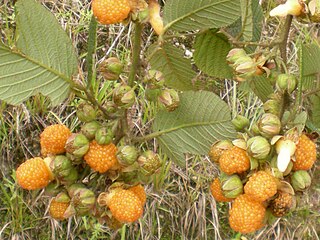
The island fox is a small fox that is native to six of the eight Channel Islands of California. There are six subspecies, each unique to the island it lives on, reflecting its evolutionary history. They are generally docile, show little fear of humans, and are easily tamed. Island foxes played an important role in the spiritual lives of native Channel Islanders. They have been likely semi-domesticated as pets, used as pelts, or for other functions, like pest control.

Banksia littoralis, commonly known as the swamp banksia, swamp oak, river banksia or seaside banksia and the western swamp banksia, is a species of tree that is endemic to the south-west of Western Australia. The Noongar peoples know the plant as pungura, boongura or gwangia. It has rough, crumbly bark, linear, more or less serrated leaves arranged in whorls, yellow flowers and up to two hundred follicles in each head.

Heritiera littoralis, the looking-glass mangrove is a large tree with wing shaped nuts, which is most easily recognised by the silvery scales on the underside of its leaves, which therefore appear green from top and white from below, although Litsea mellifera A.C. Smith, has the same type of leaves. The tree is usually found to grow along the seashore in Bangladesh & Indian Subcontinent, Southeast Asia and Tropical Africa.

Spodoptera littoralis, also referred to as the African cotton leafworm or Egyptian cotton leafworm or Mediterranean brocade, is a species of moth in the family Noctuidae. S. littoralis is found widely in Africa, Mediterranean Europe and Middle Eastern countries. It is a highly polyphagous organism that is a pest of many cultivated plants and crops. As a result, this species was assigned the label of A2 quarantine pest by the EPPO and was cautioned as a highly invasive species in the United States. The devastating impacts caused by these pests have led to the development of both biological and chemical control methods. This moth is often confused with Spodoptera litura.

Allocasuarina littoralis, commonly known as black sheoak, black she-oak, or river black-oak, is an endemic medium-sized Australian tree. A. littoralis is named for its growth near the coast; this is somewhat misleading, as it will grow well both inland and in coastal zones.

Rubus ellipticus, commonly known as aiselu, golden evergreen raspberrygolden Himalayan raspberry or as yellow Himalayan raspberry, is an Asian species of thorny fruiting shrub in the rose family.
Adenanthos ellipticus, commonly known as the oval-leaf adenanthos, is a flowering plant from the family Proteaceae that is endemic to Western Australia where it is considered to be Declared Rare Flora.

Chaetocoelopa littoralis, commonly known as the hairy kelp fly, is a fly of the family Coelopidae. It is endemic to New Zealand. These flies are black in appearance and show large variation in size, with males tending to be larger and more robust and 'hairy' than females. C. littoralis can also be observed resting on surfaces including cliff faces and driftwood in large aggregations.
Armadilloniscus holmesi is a species of woodlouse in the family Detonidae. It is found in North America, temperate Asia, and Mexico.

Armadilloniscus is a genus of woodlice in the family Detonidae. There are more than 30 described species in Armadilloniscus.

Detonidae is a family of woodlice in the order Isopoda. There are at least 3 genera and more than 30 described species in Detonidae.
Selenophorus ellipticus is a species of ground beetle in the family Carabidae. It is found in North America.

Xyonysius is a genus of seed bugs in the family Lygaeidae. There are about 10 described species in Xyonysius.
Aleochara littoralis is a species of rove beetle in the family Staphylinidae. It is found in North America.
Xysticus ellipticus is a species of crab spider in the family Thomisidae. It is found in the United States and Canada.
Armadilloniscus lindahli is a species of woodlouse in the family Detonidae. It is found in North America and Mexico.
Cercyon littoralis is a species of water scavenger beetle in the family Hydrophilidae. It is found in Europe & Northern Asia and North America.

Necrodes is a genus of carrion beetles in the family Silphidae. There are at least four described species in Necrodes.
Neomolgus littoralis is a species of snout mite in the family Bdellidae. It is found in Europe.
Neomolgus is a genus of snout mites in the family Bdellidae. There are more than 20 described species in Neomolgus.











